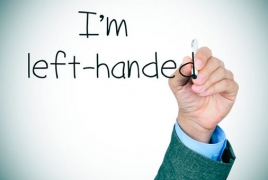
Halpern and Coren took a list of the people who had recently died (the studies were conducted in Southern California) and contacted their families, asking whether or not their relative had been right- or left-handed. Looking at 2,000 cases, they saw that the average age at death of the left-handers was about nine years younger than of the right-handers. On that basis, they concluded that left-handers died earlier.
"It's not at all plausible," reacted Chris McManus, professor of psychology and medical education at University College London and the author of Right Hand, Left Hand. "If this were true it would be the largest single predictor we had of life expectancy - it would be like smoking 120 cigarettes a day plus doing a number of other dangerous things simultaneously. It really is highly implausible that an epidemiologist wouldn't have spotted it previously."

Christian Jarrett, the author of The Rough Guide To Psychology and the editor of the British Psychological Society’s Research Digest blog, supports McManus: Halpern and Coren analyzed death records for baseball players and found that those who were left-handed had died younger. But as Chris McManus explains, this is a statistical artefact borne by the fact that left-handedness increased through the 20th century, meaning that left-handers, on average, were born later in that century. As an analogy, McManus points to Harry Potter fans, who tend to be younger than non-fans. “Ask the relatives of a group of recently deceased people whether their loved one had read Harry Potter and inevitably one will find a younger age at death in Harry Potter enthusiasts,” he writes, “but that is only because HP readers are younger overall.”
"The natural rate of left-handedness is around 10% or 11%, but the rate was pushed down artificially during the Victorian period (1837–1901)," McManus says.
Not only would left-handed people have been encouraged not to be during this period, life was also pretty difficult for them and they quickly became very conspicuous.
"They went to work in factories using machines designed for right-handers - and the left-handers looked awkward," McManus says. "And then compulsory schooling came along and they were obliged to sit in classrooms and try and write with their right hand using an ink pen and they made a mess. The result of all of this was that left-handers became stigmatized - regarded as cack-handed, stupid."

Meanwhile, in a 2009 study of children 11 and younger, Australian researchers found that left-handed kids performed worse than right-handers several measures, including vocabulary, reading, writing, social development, and gross and fine motor skills. Mixed-handed kids performed even worse than lefties.
Mixed-handed and left-handed children are more likely to use the two halves of their brains in unusual ways, which may put them at risk for mild learning disabilities, said Ronald Yeo, professor of psychology at the University of Texas-Austin.
At the same time, however, some mixed-handed kids have an unrelated learning disability that's making them struggle to decide which hand to write with. Either way, most kids catch up with their classmates as they get older, he said, being left-handed or mixed-handed isn't a surefire predictor of how well kids perform as they grow up.
Some researchers linked left-handedness to stress during pregnancy. In one British study, the fetuses of super-stressed pregnant women were more likely to touch their faces more with their left hands than their right. This could be the first signs of a left-handed child, say the researchers. Other evidence supports that theory. In one 2008 Swedish study of moms and their 5-year-old children, women who were depressed or stressed during their pregnancies were more likely to have mixed- or left-handed kids. In other studies, babies with low birth weight, or born to older mothers, were more likely to be lefties as well.
Some even believe that left-handedness is linked to a higher risk of mental health problems. People who are left-handed are at greater risk of psychotic disorders such as schizophrenia, according to a 2013 Yale University study. When researchers polled patients at a mental-health clinic, 40% of those with schizophrenia or schizoaffective said they wrote with their left hand.
There's still one thing that most handedness experts can agree on: lefties have the upper hand when it comes to one-on-one sports like tennis, boxing, and pitching a baseball.

U.S ex-President Barack Obama; Microsoft founder, entrepreneur and philanthropist Bill Gates; talk-show queen Oprah Winfrey; atomic scientist Marie Curie; guitarist Jimi Hendrix; Israeli Prime Minister Benjamin Netanyahu; banker David Rockefeller and automobile manufacturer Henry Ford are among the world’s famous lefties.

